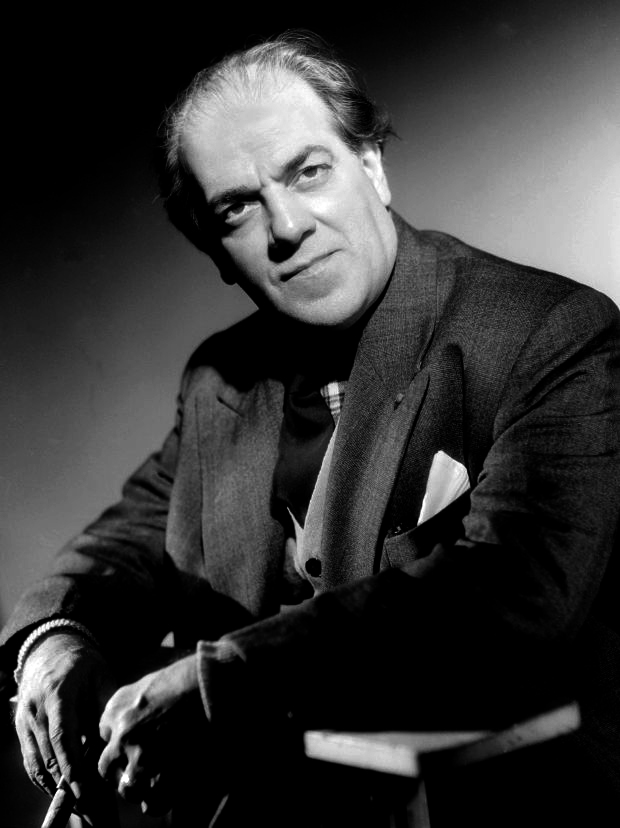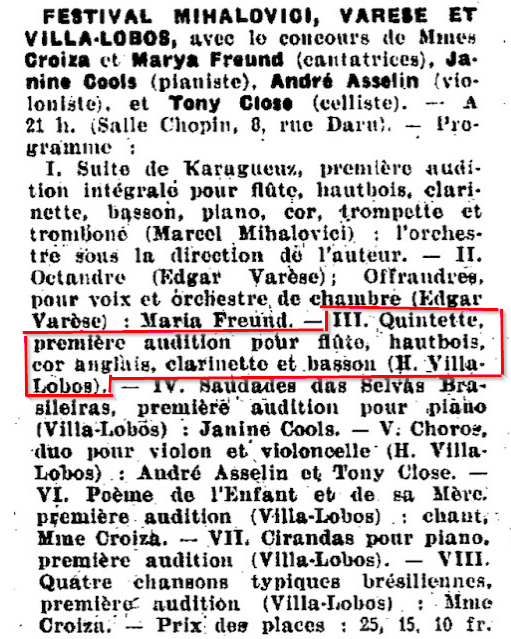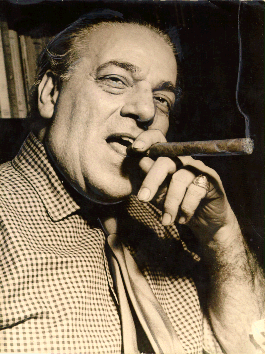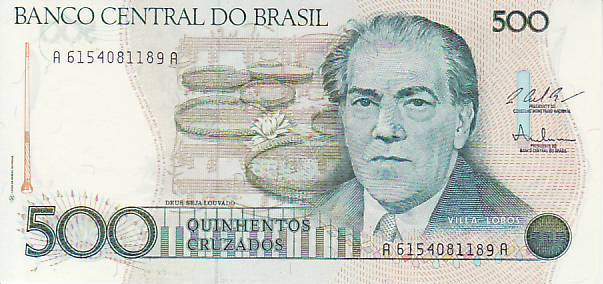Brazilian Music for Parisians

Villa-Lobos as a Young Man
Heitor Villa-Lobos was born March 5, 1887 in Rio de Janeiro, Brazil, and died there on November 17, 1959. In addition to being Brazil’s most famous composer (writing over 2000 works), he was also active as an educator and conductor.
Villa-Lobos was born to a well-off family who appreciated music and art, and he learned guitar, cello and clarinet at an early age from his father. He was talented enough that when his father died in 1899 (when Heitor was twelve years old), he was able to help the family’s finances by playing cello in theater and movie houses. He also learned to play guitar (and other instruments) with a variety of urban street and club musicians playing Choros and other popular Brazilian music.
The Choro
An important part of Villa-Lobos’s work in the 1920s was the creation of a series of works with the title “Choro.”
According to research by Janet Grice (link below in the credits), the Choro (pronounced “shore-roo”) was an Brazilian urban musical style that dates as far back as the 1870s, featuring improvisation, variations and counterpoint. Between 1899 and 1919 (starting when he was still 12), Villa-Lobos frequently performed with these street musicians as well as performing in Rio’s opera, theater and movie house orchestras.
The translation of the word, Choro, is “weeping” and the performers were called “chorões” or “weepers” or “cryers.” Some Choros are slow and sentimental, and others fast and highly syncopated, approaching the samba style. This style may have evolved from the African xolo (pronounced “sho-lo”) which evolved to “choro”.
Typically, a Choro ensemble included solo wind instruments (flute, clarinet or saxophone) with guitar and other string and percussion instruments.
This popular form became a rich treasure of ideas and forms for Villa-Lobos to exploit in a series of works he titled Choros. His Quinteto em Forma de Choros distinguishes itself by being “in the form of a Choros” rather than having the actual title, Choros, as his other works of this form had.
The Villa-Lobos biographer David Appleby writes:
“The idea of using the title Choros was an earlier concept, expressed in Choros No. 1, for guitar, written in 1920. In the Choros series he sought to amplify the idea of providing a panoramic view of the improvisatory techniques of street musicians….”
—From Heitor Villa-Lobos: A Life (1887-1959)
After quoting Appleby, John Patykula, in “Villa-Lobos and the Choro,” further explains:
“The fourteen Choros, thirteen of which were composed between 1924-29, are considered Villa-Lobos’ most original and innovative compositions. These works, composed when Villa-Lobos was in Paris, were inspired by the music of the chorões but utilizing the compositional language prevalent at that time in Europe, particularly in Paris. Paris was considered the artistic capital of the world, and its audiences were hungry for the sounds and rhythms from far-off exotic lands like Brazil. Villa-Lobos was quick to realize that he could make his fame with this type of music.”
The Quintet
Villa-Lobos was a colleague and friend to the younger Oscar Lorenzo Fernandez (also in Rio) who wrote a woodwind quintet in 1927, celebrated as the first Brazilian woodwind quintet, in Rio de Janeiro. The newest biography of Villa-Lobos in Grove Music Online by Luiz Fernando Lepes, explains that Villa-Lobos made three extended trips to Paris in 1923-1924, 1926-1929, and later in 1929 to 1930. With that schedule, it is entirely plausible that Villa-Lobos had not heard the woodwind quintet by his Brazilian compatriot. So Villa-Lobos’s first hearing of a quintet ensemble was likely French, or possibly German. Villa-Lobos’s quintet was likely the second Brazilian woodwind quintet, although the scoring is different. In any case, Villa-Lobos likely had few preconceptions of what a woodwind quintet “should” be like.
The Quinteto em forme de chôros (Quintette en forme de Chôros in French) is a single-movement work scored for flute, oboe, English horn, clarinet, and bassoon, composed in 1928, with the Appleby Catalogue W number: W231. It was published by Editions Max Eschig in Paris and still may be ordered from them.
The International Music Score Library Project has the original printed score available for download in those countries in which the copyright has expired (which currently is mainly in Canada, Japan, South Korea and China).
Yes, I’m Brazilian – very Brazilian. In my music, I let the rivers and seas of this great Brazil sing. I don’t put a gag on the tropical exuberance of our forests and our skies, which I intuitively transpose to everything I write.
— Heitor Villa-Lobos
The work was first performed in 1930 in one of Villa-Lobos’s final concerts in Paris before his return to Brazil later in the year. The Villa-Lobos Blog has preserved a concert announcement from La Semaine a Paris for the March 14, 1930 concert in the Salle Chopin. The concert of avant-garde works, also featured compositions by Edgard Varese (Octandre and Offrandres) and several other works by Villa-Lobos: Saudades das Selvas Brasileiras, Deux Choros Bis, Poeme de l’Enfant et Sa Mere, Cirandas, and Chansons typiques bresiliennes.

According toVilla-Lobos, Sua Obra [Villa-Lobos, His Works] of the Museu Villa-Lobos in Rio de Janeiro, the quintet players in the 1930 premiere were flutist Gaston Crunelle; clarinetist Louis Cahuzac; oboist Louis Mercier; English hornist Paul-Gustav Brun; and August Lenom on bassoon. (The Catalog — which released its fourth edition in 2021 — appears to be the primary source for the same personnel list in the French and English versions of Wikipedia. See below for a link.)
As the title suggests, Villa-Lobos intended this work to imitate the improvisational method of the original Choro (described above), often featuring one or more higher-voiced instruments over Latin rhythms in the bass. It appears that Villa-Lobos wanted the performers to emphasize the Latin feel of the rhythm, which might vary slightly from the exact rhythm notated (similar to jazz in that respect). The cadenza-like sections, likewise, allow the players to play with the rhythm and tempo before settling into the next section’s rhythms.
According to Janet Grice, “the contrapuntal treatment of some passages (such as the Tres lent section…) is also associated with the popular choro performance practices. Keeping this in mind, the attempt to synchronize the disparate parts in performance shouldn’t outweigh the overall mood of the seemingly chaotic yet brilliant improvisations.”
Normally taking between ten and eleven minutes to perform, the quintette is in a single movement. However, Janet Grice notes that the work has several distinct sections:
“The short quintet – one movement subdivided into small sections – can be broken down into the following sequences: an Introduction of short motifs without any clearly defined key; a markedly rhythmic section with sforzato syncopations in changing meters; a singing sentimental, melodic section similar the modinha or valsa-choro styles; virtuoso solos for different instruments used as transitions between various sections; a coda based on a rhythmic-melodic ostinato that gradually accelerates and intensifies in volume, bringing the work to a climax.”
For the performers, there is plenty of rhythmic complexity to challenge them, as well as opportunities for each instrument to show off melodically and technically. Even as the melodic material elides between major and minor keys, the accompaniment often uses popular Latin rhythms to hold the work together. The ending builds dynamically and in tempo to what our quintet liked to refer to as a “primal scream.”
All in all, the nature of the composition and the improvisational style it imitates allow the individual ensemble to mold their own unique interpretation rather than just imitate what other ensembles have done.
English horn vs. French Horn
Another choice that each ensemble needs to make is whether to follow Villa-Lobos’s original orchestration of English horn, or to use the standard woodwind quintet French horn.
The part on French horn part is virtuosic and a challenge for any horn player, allowing the horn to stand out in the ensemble.
The English horn creates an all-woodwind ensemble, with three double reed instruments. This entirely changes the sound of the ensemble, with the English horn having its own opportunities to shine, but also blending in with the other players in a way that the French horn cannot.
Many years ago, a quintet of Baltimore Symphony players performed the Villa-Lobos Quintette at a conference of the International Double Reed Society. It was the only time I heard a live performance of the work with English horn. (It was a fairly spectacular performance as I remember.) I also spoke with the ensemble’s usual French hornist (a friend of mine from an American Wind Symphony tour) afterwards, who was quite annoyed that he hadn’t been able to perform the work himself. I did mention the obvious, that it was a “Double Reed” society performance and that the English horn part was therefore, more appropriate. He was not assuaged, however.
So, rather than annoy a fifth of the ensemble, most established woodwind quintets will perform this work with French horn. Most of the available online performances listed below follow suit, but there is more than one performance with English horn to illustrate the very different timbre that results. In particular, some of the duets between oboe and English horn and English horn and bassoon make much more sense with double reeds.
Personally, I think the English horn sound fits the overall composition better and may better reflect the Choro sound that the composer was imitating. (Obviously, Villa-Lobos thought so, too.) On the other hand, the improvisational nature of the Choro offers a flexibility that can allow use of the French horn, too. Each ensemble needs to make its own decision. For some quintets, an English horn isn’t even an option and it would be a shame to forego this piece because of it.
Other Villa-Lobos Works for Winds
Heitor Villa-Lobos wrote many other works for winds in various combinations, several also dating from the 1920s. These include:
- Choros #2 for flute and clarinet (1924)
- Trio for oboe, clarinet and bassoon (1921)
- Choros #7 for flute, oboe, clarinet, alto saxophone, bassoon, violin and ’cello
- Quartet for Flute, Oboe, Clarinet and Bassoon (1928)
- Duo for Oboe and Bassoon (1957)
- Bachianas Brasileiras No. 6 for Flute and Bassoon W392 (1938)
- Fantaisie Concertante for Clarinet, Bassoon and Piano (1953)
- Ciranda das Sete Notas (1933) for bassoon and string quintet
- Assobio a Játo (“Jet Whistle”) for Flute and Cello (1950)
See the link to the Soni Ventorum archives, below, for recordings of all of these works.
Other Villa-Lobos works for band and wind symphony:
- Concerto Grosso for Woodwind Quartet and Wind Orchestra, W.565 (1959) written for Robert Boudreau and the American Wind Symphony. (One of Villa-Lobos’ last works.)
- Fantasia em Três Movimentos (in the form of choros) (1958) also written for the American Wind Symphony
- O Canto do Pajé (1933) for band (also arranged for chorus)
- A canoa virou (1932) for band
- Pro Pax (1912) for band “Marcha solene, em forma de dobrado”
Curiously, Villa-Lobos never wrote a work for traditional woodwind quintet (with French horn) although the Quinteto is most commonly performed that way.

Recordings Online and Off
There are a number of very good recordings of Heitor Villa-Lobos’s Quintete em forme de Choros available for listening online. To my ears, some feature tighter rhythmic ensemble, others allow the cadenza sections a bit more freedom. A couple take the time to savor the harmonies a bit more. Each performance has its own idiosyncrasies and shows off the strengths of the individual players.
Quintette Moraguès’ recording is one of my favorites. The performers are Michel Moraguès, flute; David Walter, oboe; Pascal Moraguès, clarinet; Pierre Moraguès, horn; and Giorgio Mandolesi, bassoon.
A recording by the Slowind Quintet (consisting of players from the Slovene Philharmonic) is from their Album “Made in America,” with Aleš Kacjan, flute; Matej Šarc, oboe; Jurji Jenko, clarinet; Metod Tomac, french horn and Paolo Calligaris, bassoon. Although the general feel of Slowind’s interpretation seems more free, the performance is only a few seconds longer than the Quintette Moraguès’.
Windscape has a commercial recording from 2006 performed by Tara Helen O’Connor, flute; Randall Ellis, oboe; Alan R. Kay, clarinet; David Jolley, horn and Frank Morelli, bassoon. It’s from their album, The Roaring 20s, which sounds like a great name for an album (as well as a series of articles on woodwind quintets).
The Zürcher Bläserquintett from Switzerland also has a good performance by Andrea Kollé, flute; Franziska van Ooyen, Oboe; Dimitri Ashkenazy, clarinette; Thomas Müller, horn and Urs Dengler, bassoon.
Aenigma, a student quintet at the San Francisco Conservatory of Music has a 2012 recording of the Quintette, performed by Amulet Strange, flute; Leo Tsui, oboe; Jonathan Szin, clarinet; Sivan Adato, horn and Kiel Curtis, bassoon.
The Soni Ventorum Archives includes ten recordings of various wind works by Villa-Lobos, including, of course, the Quintette em forme de Chôros. These are mp3 files, not video files, and can be played via most browsers.
One more very energetic performance is a recent recording of the Imani Winds also available on YouTube.
Performances with English horn are less common than with French horn, but that IS Villa-Lobos’s orchestration. Here are a few:
The members of the Le Concert impromptu woodwind quintet with English hornist Stéphance Suchanek, is a great example of how using the English horn changes the sound of the composition. Unfortunately, neither the YouTube listing, nor the group’s website seem to include the names of the other members of the quintet. (N.B. The recording begins with a short audio “logo” which might make you think you have the wrong recording. Just wait about 10 seconds. There is also a live concert recording by Le Concert impromptu which uses French horn.) — Le Concert impromptu also has a unique arrangement of Villa-Lobos’s Assobio a Játo (“Jet Whistle”) arranged (by Bossini?) for flute, oboe, bass clarinet and bassoon with interpretive dance. The third movement is on YouTube.
A recent recording of this work is by members of Royal Academy of Music performed by Yi-Hsuan Chen, flute; Drake Gritton, oboe; Fergus McCready, English horn; Rowan Jones, clarinet; and Guylaine Eckersley, bassoon at the Angela Burgess Recital Hall, recorded on September 26, 2023.
One more all-woodwind recording by the Berliner Philharmoniker Wind Quintet has been released by the Warner Music Group – X5 Music Group in a 2015 recording. Unfortunately not only are the names of the performers not specified, the YouTube listing says the work is for Flute, Oboe and Bassoon, ignoring 2/5 of the ensemble. But it is still a creditable performance, if a bit on the stodgy side. If it didn’t use English horn, I wouldn’t be recommending it.
Credits & Resources
When I first started researching the life and music of Villa-Lobos, Indiana University had a website dedicated to Heitor Villa-Lobos as part of their Latin American music studies. Well, times change and it appears that those resources are no longer available, at least online.
A thesis on the “Quintette en Forme de Choros” by Heitor Villa-Lobos: An analysis of stylistic influences is by Peterson, Elaine Leigh, D.M.A. from The University of North Carolina at Greensboro, 2004, 150 pages; AAT 3158572.
A concise biography of “Heitor Villa-Lobos (Composer, Arranger, Conductor)” is available, unexpectedly, on the Bach Cantatas Website. It also has links to other sites.
Another short biography of Villa-Lobos is available at the Music Academy Online.
The most complete catalog of Villa-Lobos’s works appears to be Villa-Lobos, Sua Obra from the Museu Villa-Lobos in Rio de Janeiro. The PDF may be downloaded for free on that page. The catalog is in Portuguese, of course, although the web site itself is available in Portuguese, Spanish and English.
Resources used for this article:
The Villa-Lobos Magazine, is a website magazine on Blogspot. The image of the original concert announcement of the premiere performance of the Quintette was from an article on the blog site which is no longer available.
Janet Grice, “Popular Styles in Brazilian Chamber Music: Heitor Villa-Lobos’s Quinteto Em Forma de Choros and Oscar Lorenzo Fernândez’s Invenções Seresteiras”. It was originally published in The Double Reed, the official publication of The International Double Reed Society.
John Patykula, “Villa-Lobos and the Choro,” in Guitarra Magazine. Accessed through the Internet Archive Wayback Machine. The article includes the quotation from David Appleby, from his biography, Heitor Villa-Lobos: A Life (1887-1959), Scarecrow Press, 2002.
Title photo of Villa-Lobos is undated, from Biography.com, but is widely used throughout the internet. Photo enhanced for web display in Photoshop.
Photo of Villa-Lobos smoking cigar has no photographer credits. Also widely used on the internet.
Copyright © 2016-2024 by Andrew Brandt

